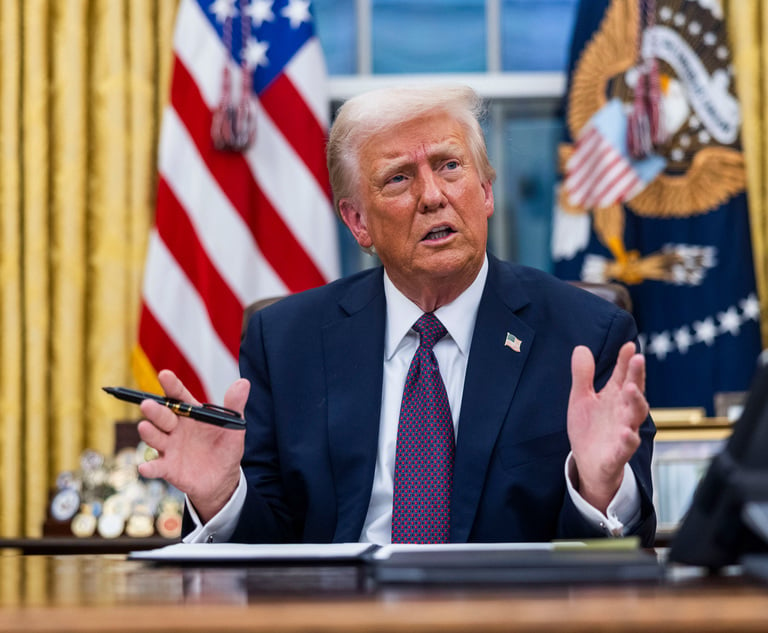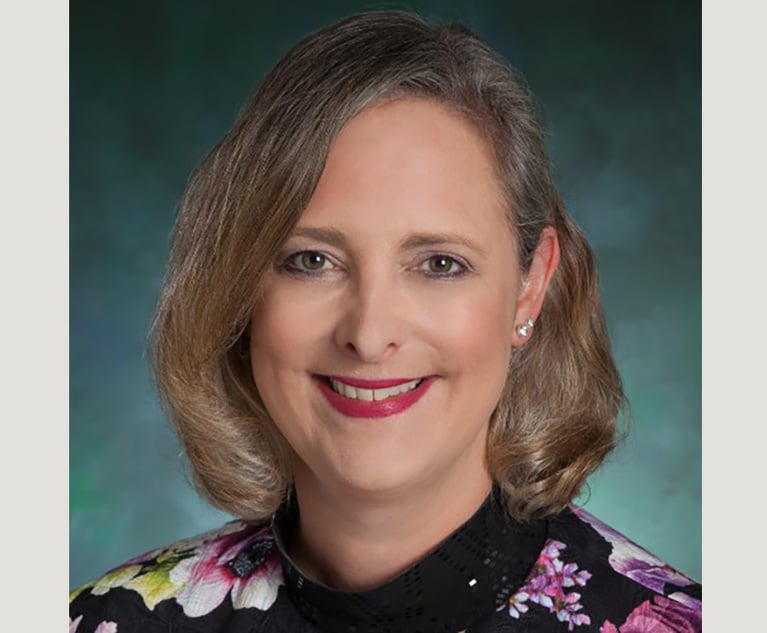Lawyers have professional responsibilities as they relate to electronically stored information
The American Bar Association (ABA) recently updated its Model Rules of Professional Conduct in a way that many lawyers will view with great fear and loathing.
December 21, 2012 at 04:00 AM
11 minute read
The original version of this story was published on Law.com
The American Bar Association (ABA) recently updated its Model Rules of Professional Conduct in a way that many lawyers will view with great fear and loathing. In a nutshell, the effect of the update is to require lawyers to keep abreast of changing technology that impacts the practice of law. Given that many lawyers quip that they went to law school precisely to avoid such technical matters, the new comment to Rule 1.1 could cause real consternation at the bar.
The new Comment [8] expresses a sentiment that has been discussed in parallel with the rise of e-discovery. Judges and lawyers have repeatedly called attention to the implications the importance of e-discovery has for the duty of competence and confidentiality. Confidentiality has already been the subject of many ethical opinions in the context of disclosure and discovery of metadata. It has also been addressed in the context of the inadvertent disclosure of privileged material, through amendments to the Federal Rules of Civil Procedure as well as the Federal Rules of Evidence. However, the duty of competence has until now not received commensurate attention.
Model Rule 1.1 requires a lawyer to “provide competent representation to a client.” Competence is defined as having the “legal knowledge, skill, thoroughness and preparation reasonably necessary for the representation.” Comment [8] to this rule now states that “[t]o maintain the requisite knowledge and skill, a lawyer should keep abreast of changes in the law and its practice, including the benefits and risks associated with relevant technology …” (Emphasis added.) There is no explicit mention of electronic discovery; the broad language of the comment undoubtedly captures other issues as well, such as those noted above with respect to confidentiality in electronic communications.
However, there can be no doubt that the technology involved in e-discovery is both relevant to “law and its practice” and rife with “benefits and risks.” A more difficult question is how to flesh out the broad language of the comment into practical guidelines lawyers can follow in order to discharge their duty of competence. It is safe to say that Comment [8] does not mean that lawyers need to become “computer geeks”—especially since Comment [2] to the same rule states that “[a] lawyer need not necessarily have special training or prior experience to handle legal problems of a type with which the lawyer is unfamiliar.” Unfortunately for some, it is the rare case these days that does not involve e-discovery.
It may be possible to identify some nonexhaustive criteria for evaluating the level of technical competence required by examining the legal obligations involved at various stages of the e-discovery process and the technical options that impact them. A lawyer advising a client on the scope of the preservation obligation would benefit by having some basic familiarity with the client's sources of electronic information that may contain relevant information. Identifying sources of information and understanding their basic characteristics relevant to retention is a necessary prerequisite to deciding how to handle them for purposes of the preservation duty.
This does not suggest that lawyers need to become experts on Microsoft Exchange or DLT backup tapes or any other system or storage media. However, the competent lawyer will develop an awareness of facts about those systems and sources that bear on preserving their relevant data. This may simply mean that lawyers have to be inquisitive enough to ask questions of the client's IT personnel, such as “where is the data?” or “what do we have to do in order to make sure the data does not get erased?”
Inside counsel who use multiple law firms to handle different kinds of litigations or investigations can make life easier by working with outside counsel and technical experts to create a “systems overview.” The systems overview is a document that identifies and describes each of the client's potential sources of electronic information, including all of the facts related to preserving, searching, collecting and otherwise handling the information for purposes of e-discovery. Such a document provides an excellent starting point for discussions between attorneys and IT personnel regarding how to carry out e-discovery on the client's data.
In addition, the duty of competence implies that the lawyer needs to understand enough to make decisions about e-discovery that impact the litigation. For example, it might be prudent to learn that if he collects targeted data by simply copying the files of interest, this may result in alteration of metadata and failure to capture deleted data that is potentially relevant and recoverable by other means, for example, forensic imaging. Likewise, the lawyer should understand how decisions about how to filter the data and use computer assisted review could impact the production.
There are too many decisions like this in the litigation process to describe them all here, but the basic point is that many technical decisions have a direct impact on the litigation process and competence requires that an attorney understand enough technology to grasp them. This suggests that a key element of technical competence for lawyers is that they should consider the limits of their own technical acumen—what you don't know could hurt you. By being aware of gaps in your technical knowledge, you can better decide when to turn to technical experts or more knowledgeable colleagues.
The ABA's Comment [8] to Rule 1.1 of its Model Rules of Professional Responsibility expresses what many e-discovery aficionados have been saying for years—that the duty of competence in the computer and Internet age requires enough knowledge of technology to be informed about its legal implications. This is an eminently sensible observation, however, translating it into practical application can be challenging. The bar that reaches professionally responsible competence when it comes to technical knowledge is hard to see clearly, although it is surely rising. Nevertheless, by examining where technical decisions impact the legal process, there is some hope of staying above that bar.
The views expressed herein are those of the author and do not necessarily reflect the views of Ernst & Young LLP.
The American Bar Association (ABA) recently updated its Model Rules of Professional Conduct in a way that many lawyers will view with great fear and loathing. In a nutshell, the effect of the update is to require lawyers to keep abreast of changing technology that impacts the practice of law. Given that many lawyers quip that they went to law school precisely to avoid such technical matters, the new comment to Rule 1.1 could cause real consternation at the bar.
The new Comment [8] expresses a sentiment that has been discussed in parallel with the rise of e-discovery. Judges and lawyers have repeatedly called attention to the implications the importance of e-discovery has for the duty of competence and confidentiality. Confidentiality has already been the subject of many ethical opinions in the context of disclosure and discovery of metadata. It has also been addressed in the context of the inadvertent disclosure of privileged material, through amendments to the Federal Rules of Civil Procedure as well as the Federal Rules of Evidence. However, the duty of competence has until now not received commensurate attention.
Model Rule 1.1 requires a lawyer to “provide competent representation to a client.” Competence is defined as having the “legal knowledge, skill, thoroughness and preparation reasonably necessary for the representation.” Comment [8] to this rule now states that “[t]o maintain the requisite knowledge and skill, a lawyer should keep abreast of changes in the law and its practice, including the benefits and risks associated with relevant technology …” (Emphasis added.) There is no explicit mention of electronic discovery; the broad language of the comment undoubtedly captures other issues as well, such as those noted above with respect to confidentiality in electronic communications.
However, there can be no doubt that the technology involved in e-discovery is both relevant to “law and its practice” and rife with “benefits and risks.” A more difficult question is how to flesh out the broad language of the comment into practical guidelines lawyers can follow in order to discharge their duty of competence. It is safe to say that Comment [8] does not mean that lawyers need to become “computer geeks”—especially since Comment [2] to the same rule states that “[a] lawyer need not necessarily have special training or prior experience to handle legal problems of a type with which the lawyer is unfamiliar.” Unfortunately for some, it is the rare case these days that does not involve e-discovery.
It may be possible to identify some nonexhaustive criteria for evaluating the level of technical competence required by examining the legal obligations involved at various stages of the e-discovery process and the technical options that impact them. A lawyer advising a client on the scope of the preservation obligation would benefit by having some basic familiarity with the client's sources of electronic information that may contain relevant information. Identifying sources of information and understanding their basic characteristics relevant to retention is a necessary prerequisite to deciding how to handle them for purposes of the preservation duty.
This does not suggest that lawyers need to become experts on
Inside counsel who use multiple law firms to handle different kinds of litigations or investigations can make life easier by working with outside counsel and technical experts to create a “systems overview.” The systems overview is a document that identifies and describes each of the client's potential sources of electronic information, including all of the facts related to preserving, searching, collecting and otherwise handling the information for purposes of e-discovery. Such a document provides an excellent starting point for discussions between attorneys and IT personnel regarding how to carry out e-discovery on the client's data.
In addition, the duty of competence implies that the lawyer needs to understand enough to make decisions about e-discovery that impact the litigation. For example, it might be prudent to learn that if he collects targeted data by simply copying the files of interest, this may result in alteration of metadata and failure to capture deleted data that is potentially relevant and recoverable by other means, for example, forensic imaging. Likewise, the lawyer should understand how decisions about how to filter the data and use computer assisted review could impact the production.
There are too many decisions like this in the litigation process to describe them all here, but the basic point is that many technical decisions have a direct impact on the litigation process and competence requires that an attorney understand enough technology to grasp them. This suggests that a key element of technical competence for lawyers is that they should consider the limits of their own technical acumen—what you don't know could hurt you. By being aware of gaps in your technical knowledge, you can better decide when to turn to technical experts or more knowledgeable colleagues.
The ABA's Comment [8] to Rule 1.1 of its Model Rules of Professional Responsibility expresses what many e-discovery aficionados have been saying for years—that the duty of competence in the computer and Internet age requires enough knowledge of technology to be informed about its legal implications. This is an eminently sensible observation, however, translating it into practical application can be challenging. The bar that reaches professionally responsible competence when it comes to technical knowledge is hard to see clearly, although it is surely rising. Nevertheless, by examining where technical decisions impact the legal process, there is some hope of staying above that bar.
The views expressed herein are those of the author and do not necessarily reflect the views of
This content has been archived. It is available through our partners, LexisNexis® and Bloomberg Law.
To view this content, please continue to their sites.
Not a Lexis Subscriber?
Subscribe Now
Not a Bloomberg Law Subscriber?
Subscribe Now
NOT FOR REPRINT
© 2025 ALM Global, LLC, All Rights Reserved. Request academic re-use from www.copyright.com. All other uses, submit a request to [email protected]. For more information visit Asset & Logo Licensing.
You Might Like
View All
Netflix Music Guru Becomes First GC of Startup Helping Independent Artists Monetize Catalogs
2 minute read
FTC Finalizes Child Online Privacy Rule Updates, But Ferguson Eyes Further Changes


Global Software Firm Trying to Jump-Start Growth Hands CLO Post to 3-Time Legal Chief
Trending Stories
- 1Who Are the Judges Assigned to Challenges to Trump’s Birthright Citizenship Order?
- 2Litigators of the Week: A Directed Verdict Win for Cisco in a West Texas Patent Case
- 3Litigator of the Week Runners-Up and Shout-Outs
- 4Womble Bond Becomes First Firm in UK to Roll Out AI Tool Firmwide
- 5Will a Market Dominated by Small- to Mid-Cap Deals Give Rise to a Dark Horse US Firm in China?
Who Got The Work
J. Brugh Lower of Gibbons has entered an appearance for industrial equipment supplier Devco Corporation in a pending trademark infringement lawsuit. The suit, accusing the defendant of selling knock-off Graco products, was filed Dec. 18 in New Jersey District Court by Rivkin Radler on behalf of Graco Inc. and Graco Minnesota. The case, assigned to U.S. District Judge Zahid N. Quraishi, is 3:24-cv-11294, Graco Inc. et al v. Devco Corporation.
Who Got The Work
Rebecca Maller-Stein and Kent A. Yalowitz of Arnold & Porter Kaye Scholer have entered their appearances for Hanaco Venture Capital and its executives, Lior Prosor and David Frankel, in a pending securities lawsuit. The action, filed on Dec. 24 in New York Southern District Court by Zell, Aron & Co. on behalf of Goldeneye Advisors, accuses the defendants of negligently and fraudulently managing the plaintiff's $1 million investment. The case, assigned to U.S. District Judge Vernon S. Broderick, is 1:24-cv-09918, Goldeneye Advisors, LLC v. Hanaco Venture Capital, Ltd. et al.
Who Got The Work
Attorneys from A&O Shearman has stepped in as defense counsel for Toronto-Dominion Bank and other defendants in a pending securities class action. The suit, filed Dec. 11 in New York Southern District Court by Bleichmar Fonti & Auld, accuses the defendants of concealing the bank's 'pervasive' deficiencies in regards to its compliance with the Bank Secrecy Act and the quality of its anti-money laundering controls. The case, assigned to U.S. District Judge Arun Subramanian, is 1:24-cv-09445, Gonzalez v. The Toronto-Dominion Bank et al.
Who Got The Work
Crown Castle International, a Pennsylvania company providing shared communications infrastructure, has turned to Luke D. Wolf of Gordon Rees Scully Mansukhani to fend off a pending breach-of-contract lawsuit. The court action, filed Nov. 25 in Michigan Eastern District Court by Hooper Hathaway PC on behalf of The Town Residences LLC, accuses Crown Castle of failing to transfer approximately $30,000 in utility payments from T-Mobile in breach of a roof-top lease and assignment agreement. The case, assigned to U.S. District Judge Susan K. Declercq, is 2:24-cv-13131, The Town Residences LLC v. T-Mobile US, Inc. et al.
Who Got The Work
Wilfred P. Coronato and Daniel M. Schwartz of McCarter & English have stepped in as defense counsel to Electrolux Home Products Inc. in a pending product liability lawsuit. The court action, filed Nov. 26 in New York Eastern District Court by Poulos Lopiccolo PC and Nagel Rice LLP on behalf of David Stern, alleges that the defendant's refrigerators’ drawers and shelving repeatedly break and fall apart within months after purchase. The case, assigned to U.S. District Judge Joan M. Azrack, is 2:24-cv-08204, Stern v. Electrolux Home Products, Inc.
Featured Firms
Law Offices of Gary Martin Hays & Associates, P.C.
(470) 294-1674
Law Offices of Mark E. Salomone
(857) 444-6468
Smith & Hassler
(713) 739-1250






